DISCLAIMER: Always check with a mycologist to confirm your finds and before ingesting.
With all of its lush forests and beautiful wilderness, you can bet Alaska has an amazing variety of fungi too! There are literally thousands of species of mushrooms that grow in Alaska and many of these are edible- and tasty.
Among the most popular species of edible mushrooms in Alaska are the king bolete, fire morels, and Pacific golden chanterelles. Along with mushroom hunting for edible species, many people also collect mushrooms for drying and crafting.
There’s tons of potential for mushroom hunting in Alaska and even a few festivals centered around the hunt. There’s also a great community that gets into mushroom hunting and is very welcoming to newcomers.
Between all the fresh mushrooms and great resources to lead you, there’s no reason to not go out foraging! Keep reading to see everything you need to know to begin mushroom hunting in Alaska!
Getting Started
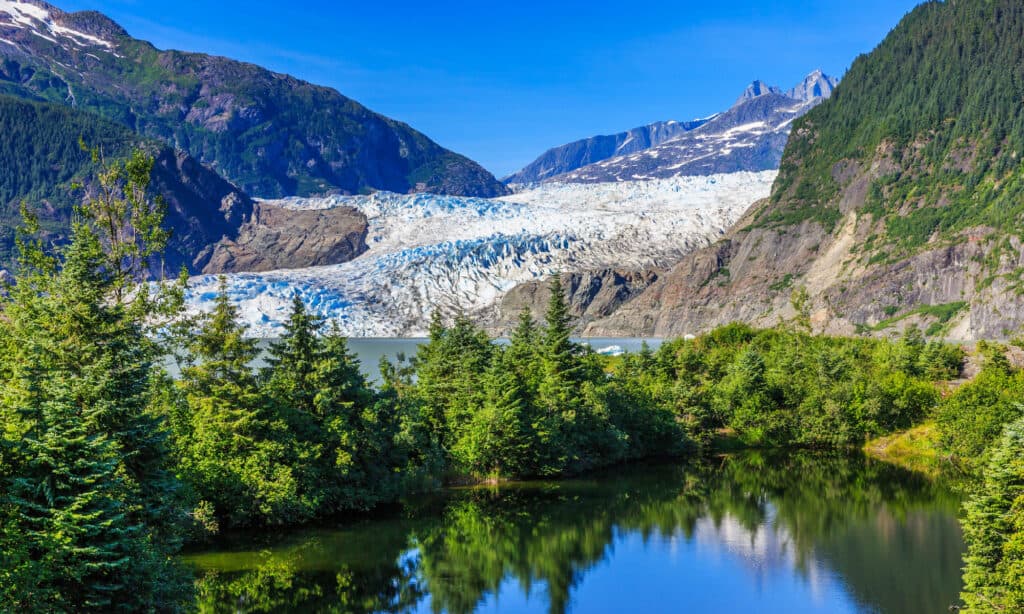
©iStock.com/SCStock
Most people are too intimidated to start learning about mushrooms because they’re worried they’ll accidentally pick a poisonous one and get very sick. Thankfully, there’s actually only a handful of really toxic mushrooms in the whole world. You’re much more likely to grab an edible, or at least non-toxic, mushroom.
However, this doesn’t mean you should go crazy picking and eating any mushroom you find. You should only ever pick a mushroom if you’re very sure of your find. Check finds by comparing with photos online or, better yet, ask an experienced mushroom hunter to confirm.
You also don’t need to be an expert to go looking for mushrooms. Most people never go foraging because they think they need to be able to identify everything they find. That’s totally not the case, though!
The best way to get started is by studying one or two, easy–to–identify, edible mushrooms and just looking for those. Remember that everyone with fungus expertise started off not knowing anything. You have to start somewhere and then build up your knowledge!
Resources for Alaska
Thankfully, there are many in-depth resources online that you can use, whether you’re just learning or trying to deepen your knowledge.
For starters, this Forest Service mushroom catalog describes over 40 mushrooms you might find growing in Alaska forests. Most of these species aren’t edible, but it’s still useful for growing your knowledge of the mushrooms in your state. The catalog also covers when and where to go.
There are also mushroom hunting groups you can join. That way, you go on hunts with others who are experienced and learn from their knowledge. There’s the statewide Alaska Mushrooms group along with the well-known and engaged Turnagain Arm Mycological Society.
Joining a group is a great way to learn tips. These might include the best hunting spots or how the local mushrooms respond to weather patterns. If you’re just starting off and aren’t sure if you want to fully join a group, go to one of the two annual mushroom festivals Alaska hosts!
The Cordova Fungus Festival is every year at the end of August. It includes excursions to go out on guided hunts. In early September, there’s the Girdwood Fungus Fair. This fair also goes out on mushroom walks and provides lots of info on hunting, crafting, cooking, and understanding mushrooms!
Laws About Mushroom Hunting
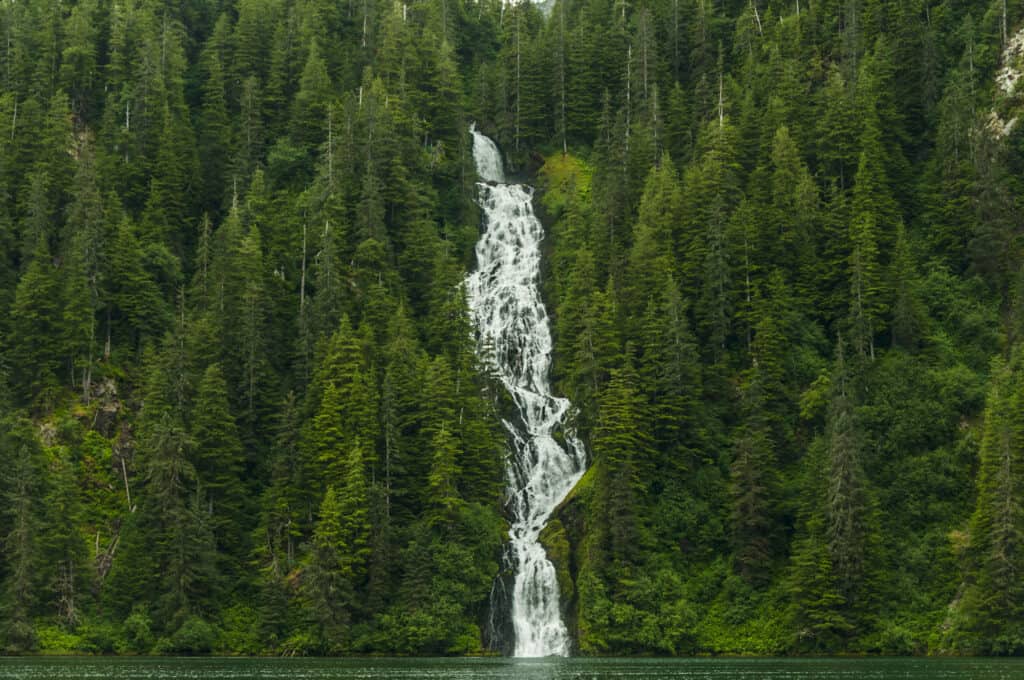
©iStock.com/RONSAN4D
You don’t need a permit to go mushroom hunting anywhere in Alaska, so long as you’re collecting for personal use. If you want to collect mushrooms to sell them, then there are different regulations. There are, however, rules about where you can go hunting since some areas are protected land.
It’s legal to collect mushrooms from National Forests all over the U.S. but each state has a different legal amount. In Alaska, you can collect up to three gallons of mushrooms per person and per day. The national forests in Alaska are Tongass National Forest and Chugach National Forest.
Most state parks in Alaska prohibit collecting any plants or fungi. Denali State Park is an exception, though, and does allow collecting mushrooms. These rules can change, so it’s best to check on the website of the state park you’re interested in visiting to see their policies.
You can go mushroom hunting on any private property with the permission of the owner. You’re always allowed to go mushroom hunting on your own property and can collect however much you find!
General Foraging Rules
Along with the laws on mushroom hunting, there are some general rules that we follow to forage in a responsible and respectful manner.
The main rule, which goes for foraging of any kind, is to only take as much as you’ll use. It can be really exciting to find something edible, especially as a beginner, and you may be tempted to take as much as you can. Keep in mind, though, that what you’re collecting is also food for forest animals and it doesn’t help anyone if it’s rotting in your fridge!
Specifically for mushrooms, always “tap the cap” to release the spores in the cap. This allows more mushrooms can pop up! The spores in mushrooms are like the seeds in fruits. It’s how they reproduce. If you pull a mushroom before it’s released its spores, it can’t keep growing.
When you’re ready to pick the mushroom, grab it from the base and gently pull so you don’t tear the mushroom or disrupt the mycelium (its root system). Some foragers even bring a pocket knife to snip mushrooms, although this isn’t necessary.
Lastly, be mindful and keep your eyes open! Mushrooms are all connected by an underground mycelial network. With that, if you spot one mushroom, it’s likely that there are several more around it. Be careful not to step on another while you’re going in to collect!
Common Edible Mushrooms
There are many types of mushrooms in Alaska that are edible, but there are a few that are especially tasty and sought after. These are called “choice edibles.” These mushrooms are at the top of any mushroom hunter’s list if you’re out looking for mushrooms for dinner!
When collecting, grab or at least examine a couple of mushrooms so you have multiple samples to confirm what you’ve found. It’s also important to keep mushrooms of different species separate so you don’t confuse which is which.
King Bolete (Boletus edulis)
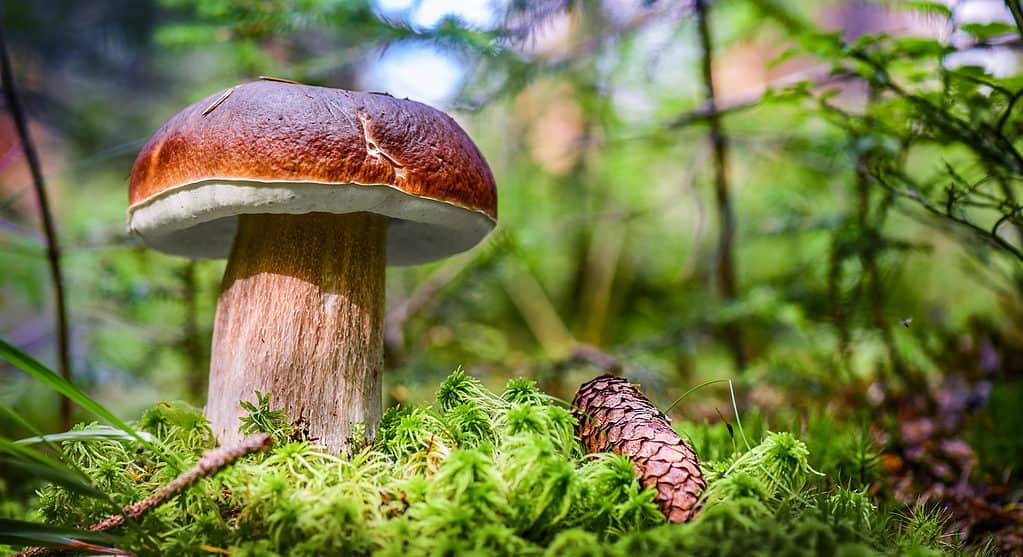
©Krasula/Shutterstock.com
The king bolete is one of the most popular edibles in Alaska. It is the North American equivalent of a porcini mushroom. It looks very similar to porcinis, but also tastes the same, so it can be used interchangeably in recipes.
King boletes are also fairly easy to identify. They’re one of two species of mushrooms in Alaska with sponge on the underside, rather than gills. Often when we think of mushrooms, we picture the elegant gills stretching under the cap. Not all mushrooms have these, though!
When you turn over a king bolete cap, you won’t find any gills but rather a thick, spongy mat that’s completely flat. So, you can immediately eliminate any mushrooms you find with gills when hunting.
King bolete mushrooms have thick stipes (stems) that are usually beige or cream-white with caps that are brown or beige. When you collect, the cap should be firm. If the cap is super squishy, this means it’s old and you shouldn’t pick it.
King boletes are often found growing near Birch or Spruce trees, or in mossy areas with lots of damp soil.
Fire Morels (Morchella tomentosa)
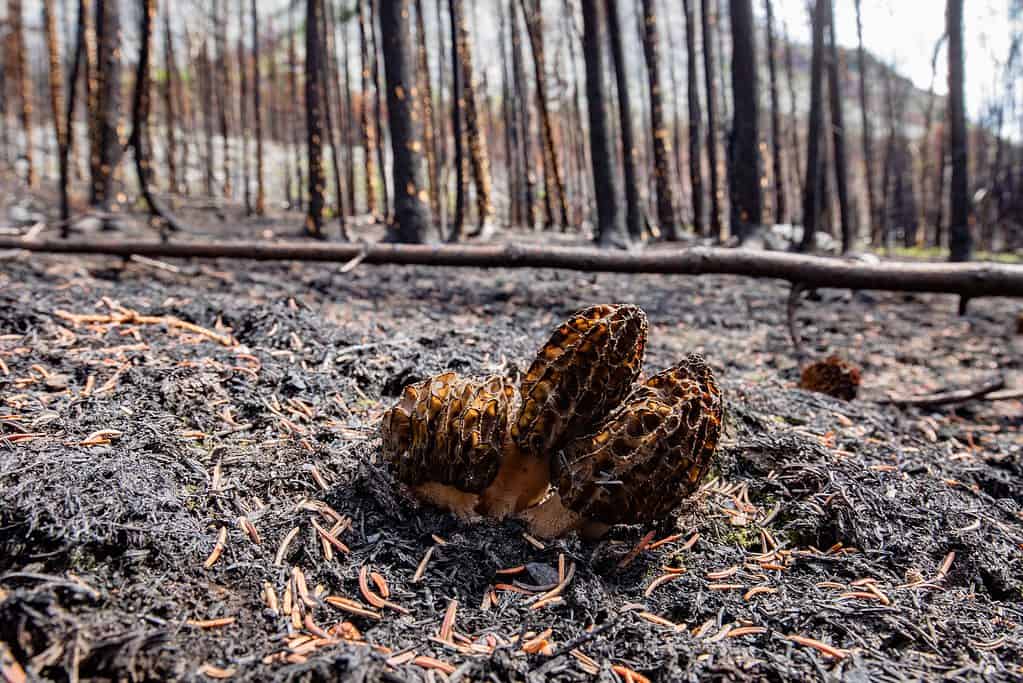
©Pi-Lens/Shutterstock.com
Fire morels are a specific type of morel mushroom that pop up in forests that have recently burned. Morel mushrooms grow all over the country, but fire morels are most often found in northwestern North America.
Morel mushrooms have a unique cap with ridges that form a honeycomb pattern. Fire morels have the same look as other morels, except they’re much darker. The stripes are brown and the caps are dark brown, almost black. They look like they were actually burned!
There is a toxic lookalike — the “false morel” — but it’s fairly easy to tell them apart. If you think you have a morel, cut it open. True morels are hollow all the way through.

©FotoLot/Shutterstock.com
Specifically for Alaska, fire morels can be found in forests with recently burned conifer trees. These mushrooms need warmth to come up. Because of that, they won’t pop up until May or June, depending on where you are.
Pacific Golden Chanterelle (Cantharellus formosus)
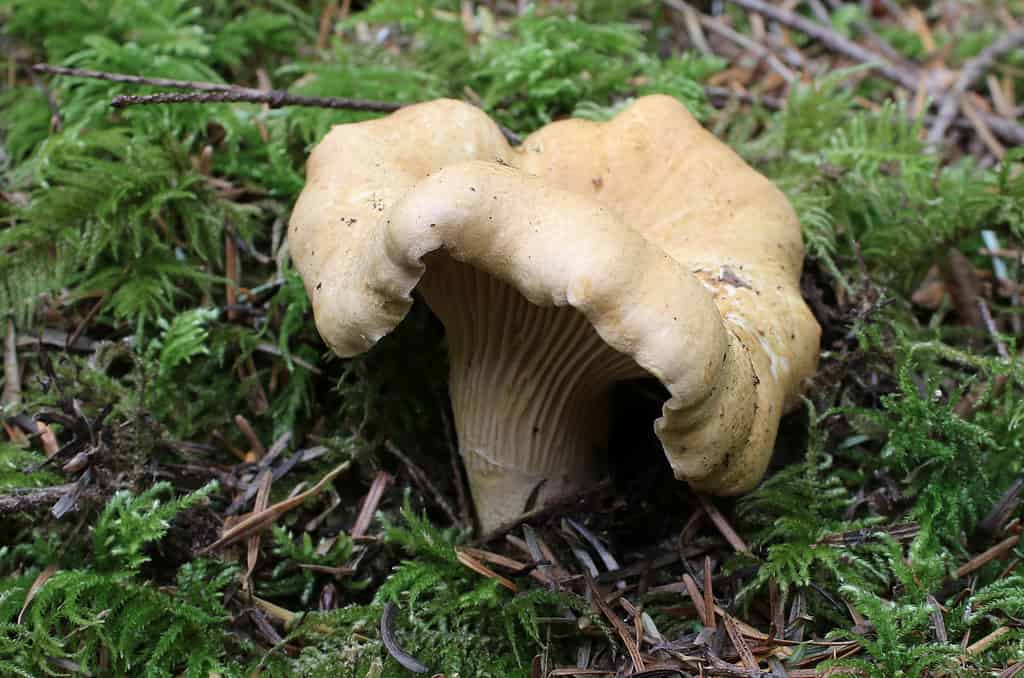
©Randy Bjorklund/Shutterstock.com
There are over 15 species of chanterelle mushrooms, with varying looks and flavors. The golden chanterelle is one of the most well-known. If you’ve seen a chanterelle before, you’ve likely seen the bright-orange golden chanterelle, since it’s the most common in stores.
It’s also quite expensive in specialty produce markets, so it’s a real treat to find in the forest! Golden chanterelles have a fresh and peppery taste that makes them choice edibles.
These chanterelles have orange caps and orange-white gills. They’re trumpet-shaped and don’t have a clear distinction between the stipe and the cap.
Jack O’Lantern mushrooms look similar to golden chanterelles and are toxic, so be sure to study both and know the differences.
Golden chanterelles are often found in southeastern Alaska, in forests with Oaks and Conifers. These mushrooms always grow in connection with a tree and can be found at the base of trees. More specifically, usually hardwoods, but sometimes pine trees as well.
Toxic Mushrooms in Alaska
Just as you need to know what you’re hunting for, you should also know what to avoid. You don’t need to be an expert on these toxic mushrooms, but it’s good to have an idea of what you might come across.
Yellow Patches and Grisette
Yellow patches (Amanita augusta) and grisettes (Amanita vaginata) are related and are both highly toxic. Because they’re related, they grow in similar ways but look slightly different.
The Yellow patches mushroom has a brown cap with yellow “warts” and a yellow-white stipe. Grisettes have a more gray-brown cap that doesn’t have any warts.
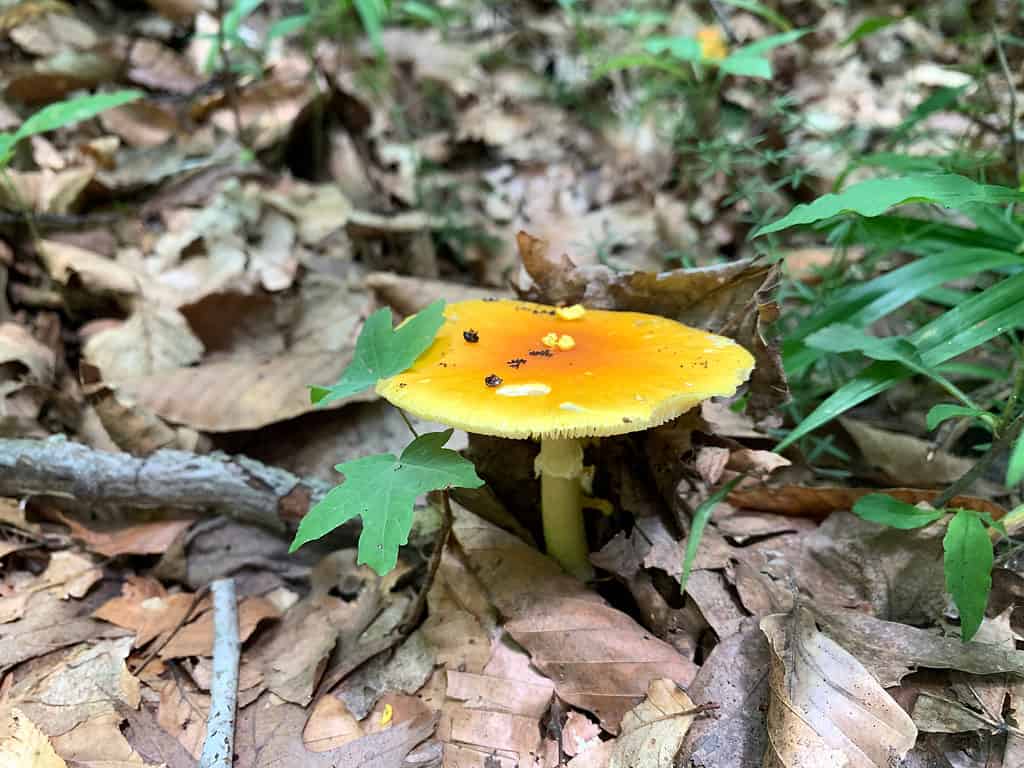
©CampSmoke/Shutterstock.com
They’re both large mushrooms, several inches tall, with a flat cap that’s several inches across. However, when they’re young they begin in an “egg phase” where they’re small and resemble edible puffball mushrooms. This is why it’s important to know exactly what you’re picking!
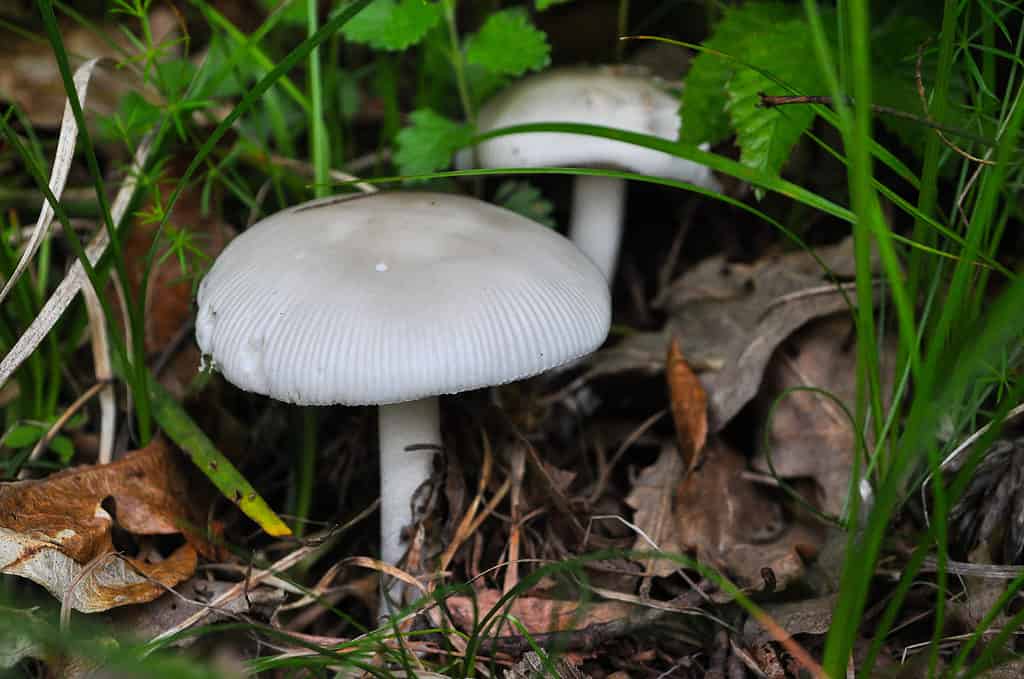
©Ivan Marjanovic/Shutterstock.com
Amanita mushrooms typically grow near each other, but not in clusters. There will be several around the same tree. This is called a “troop.”
Fairy Bonnet Mushrooms / The Genus Mycena
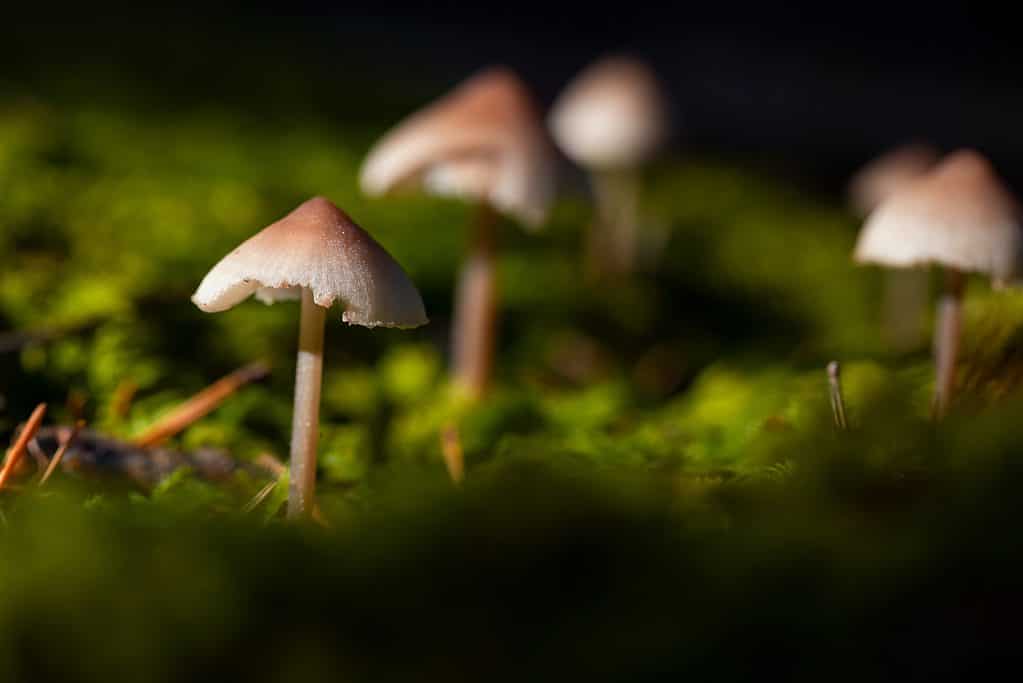
©Tereza Tothova/Shutterstock.com
There are several mushrooms in the Mycena genus that are toxic, although not all of them are! However, until you know how to identify the exact species, it’s a good idea to stay away completely.
These mushrooms are tiny. They’re only a few inches tall, topped with a delicate cap that droops down like a tiny umbrella. They’re very well named because their caps definitely look like fairy bonnets!
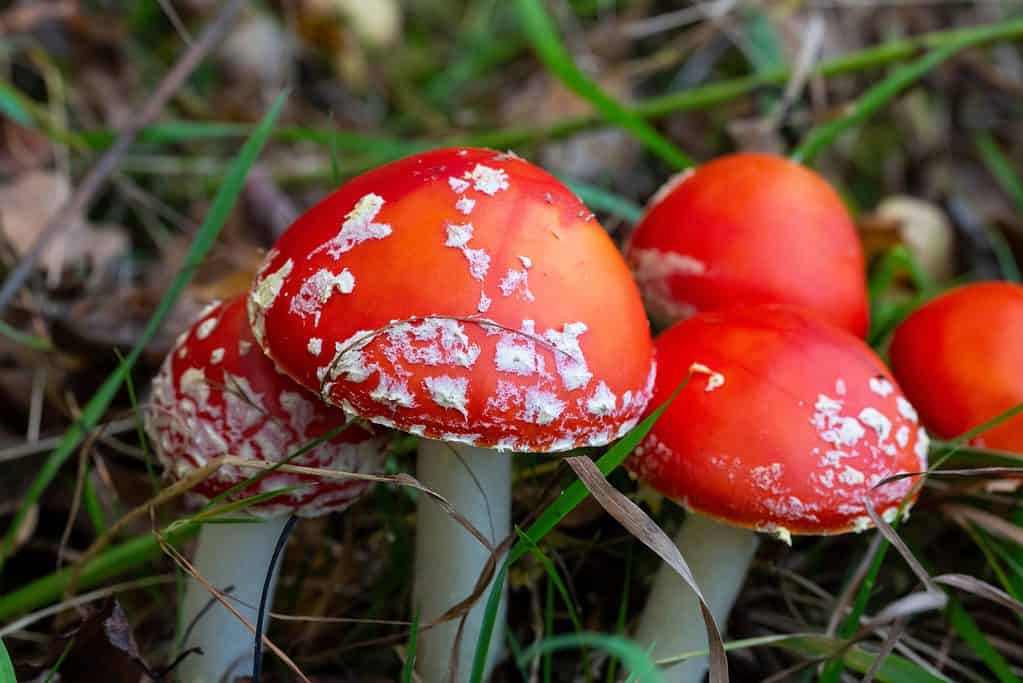
©FotoLot/Shutterstock.com
Some of the toxic species are bright pink or orange. Others are brown and could be mistaken for any mushroom. Again, it’s better to be safe than sorry! All Mycena mushrooms have a glistening, slimy texture to their caps.
Where To Go Mushroom Hunting
Of course, you need to start by going to an area where it’s allowed to go mushroom hunting, but once you get there- where do you go? National forests and state parks are huge and you’ll need some direction as to where to look otherwise, you’ll be searching for days!
Learning about local spots is best done by joining a mushroom foraging group, so you can hear from the people that have been going for years. For now, below are some tips.
Generally, mushrooms need moisture to come up. So, look along streambanks or riverbeds or anywhere in the forest where there’s very moist soil. They also need nutrients to grow, so a forest floor covered in leaves or plant matter is perfect ground for mushrooms.
Many mushrooms also grow symbiotically with trees, so it’s you’ll find these mushrooms at the base of a tree. Many also grow on dead, fallen trees to decompose them.
Lastly, mushrooms often grow in troops, since they’re all connected to the same mycelial network, so if you see one, keep an eye out for more!
When To Go Mushroom Hunting
It’s also very important to know when to go looking for mushrooms. As with any other living being, mushrooms have their peak seasons and won’t be found year-long.
Mushroom season is spring through fall, which in Alaska is May through September. In the northern parts of the summer, you’ll need to go in peak summer while temperatures are warm enough. Regardless of where you are, go before the first frost because temperatures that low will stop mushroom growth.
However, if you’re going out looking for a specific mushroom, look up its season. For example, morels are found in the spring, while chanterelles and king boletes come in late summer.
Since mushrooms need moist soil, you’re most likely to find mushrooms after a long spring or summer rainfall. Head out a day or two after several days of rain and you’ve got a good chance of finding some fresh mushrooms!
Begin the Hunt!
You’re probably not an expert and likely still have lots to learn, but use this as excitement, not intimidation! It’s a great thing to have begun something new and you can decide how deep you want to get with your research.
Go on and do some more research, connect with other mushroom hunters, and go check out the mushroom festivals in Alaska!
Mushroom hunting is something you can continue to learn about for the rest of yourself, or you can just get good at identifying those you like to eat. The choice is completely yours!
However, you won’t really understand until you go out looking for mushrooms. Plus, a walk in the woods is always good for you! I hope this article gives you the confidence to begin your mushroom-hunting adventures!
Up Next…
- The 6 Best Books About Mushrooms for Beginners and Enthusiasts!
- What is the Best Month for Mushroom Hunting?
- The 10 Best Culinary Mushrooms
- Discover 10+ Different Types of Wild, Edible Mushrooms
The post Mushroom Hunting in Alaska: A Complete Guide appeared first on AZ Animals.
from Animal News, Facts, Rankings, and More! - AZ Animals https://ift.tt/2pskixT